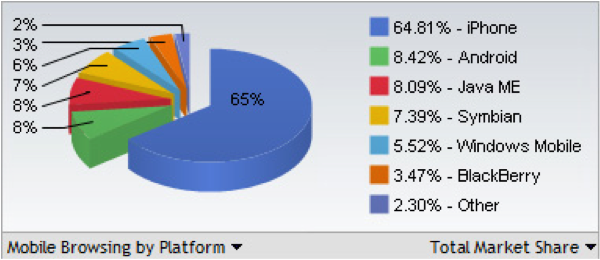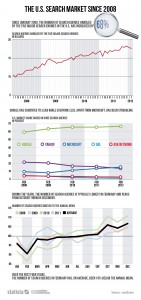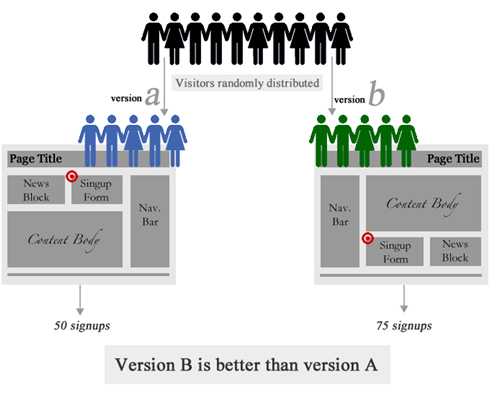Sharp Innovations Blog
Even Though Bing Surges, Google Still Tops US Searches
April 10, 2012Google, the worldwide search engine leader, has some competition. Bing, Microsoft’s search engine, has steadily crept up search engine rankings since it debuted in 2009, and is now in the number two spot for the first time. Google and Bing’s trajectories appear approximately parallel, while the rest of the competition’s rankings continue to dip.
According to comScore, Bing and Microsoft’s other websites had a respectable 2.7 billion U.S. search requests in February 2012, but Google still remained on top with 11.7 billion search requests. Yahoo ranked third with 2.4 billion requests. Ask Network came up two percent in February to reach 535 million search requests, and AOL, Inc. had 266 million.
What do these statistics mean for your business? Basically, search marketing, or search engine optimization (SEO), is more important than ever. With the right SEO team, you can increase lead generation and bring in more traffic to your site. Ultimately, it is possible to take advantage of Bing’s surge and the increasingly competitive search engine market to increase sales for your business. Let Google and Bing duke it out, and reap the benefits by hiring a great SEO team.
Graphic courtesy of Statista.com.
Smart Phones vs. the Personal Computer
March 8, 2012According to data collected by online search giant Google, more consumers in each of five key global markets now have an Internet-capable mobile device than have a desktop or laptop computer. In the United States, the difference is creeping toward 10% more (76% to 68%), although consumers still report accessing the Internet on multiple types of devices. Still, Morgan Stanley analyst Mary Meeker believes that, “Within the next five years, more users will connect to the Internet over mobile devices than desktop PCs.” Based on her predictions, she expects mobile data traffic to increase by almost 4,000 percent by 2014.
In addition, online tech blogs like The Verge are reporting that more Americans have smart phones than traditional feature phones, and research from the Canalys group backs this up by estimating that 487.7 million smart phones were shipped in 2011—an increase of over 60 percent from 2010. Adding fuel to the fire, Canalys doesn’t expect the increase in smart phones to continue as rapidly next year, but suggest that’s only because manufacturers will focus on higher-end models and greater profitability, instead of pushing a larger number of low-end products.
Changes to Google Search Results
November 6, 2011How will it affect your business?
Google announced last week that there would be another fundamental change to their search algorithm to help index new content as fast as possible. This update, called “Freshness,” will affect about 35% of all search queries. It will mostly target highly talked about news items (such as celebrity breakups and the world economy, for instance) but may also impact search queries that are broad-matched keywords such as “football.”
With the increasingly high number of people utilizing social media, blogging and news related sites, Google has taken the indexing of results in real-time by the horns. The change has already been showing in the results. Following is an example of the results in real-time for the search query “Barack Obama.”

As you can see, there is a time stamp of 17 minutes next to the most recent news item. For those businesses that have news feeds and blogs, this could have the potential to be a large outlet for pushing keyword-related content. Google still says “content is king” amongst keyword rankings, so the more quality content a business can generate, the better chance they’ll have of ranking well in search results.
2011: Design Less Restricted
October 21, 2011While the Internet itself is still relatively young, it changes a little bit every year. In 2010, design for mobile devices boomed, typography emphasis flourished and many other aspects of web design took leaps forward as well. But now that 2011 has come and 2012 is nearly upon us, what’s coming next?
The Death of Flash
Adobe Flash was once a widely used tool thanks in no small part to its easily implemented interactivity, but its best days may be behind it. HTML5 and CSS3 are quickly becoming its replacement. For those not affiliated with Adobe, this is largely an exciting and welcome change because it will allow for more cleanly produced designs and the reduction of load times.
There are many reasons for the move from Flash. One factor is the implementation of CSS3 transitions and animations. These make it easier to create moving backgrounds, growing buttons, fading objects, and many other flourishes. Additionally, many JavaScript libraries are also growing in use, and allow for a more rich and interactive user experience. A prime example is that of jQuery. The jQuery slogan of “Write less, do more” is particularly apt, since it allows designers to more easily add interactivity, user feedback, etc. while the technical writing is simple and clean. One current trend in web design that takes advantage of this language is the single page website. These sites dynamically move content as a method of producing a clean and centralized design. Since that jQuery it is not a proprietary language, it will cleanly integrate with the other elements of the website—something that can’t be said of Flash.
Aside from competing technologies, the decline of Flash can also be attributed to the growth of the mobile market, in which Flash is weakly supported, if it is supported at all.
The Importance of A/B Testing
So you have a great website, traffic is good and you are receiving inquires. But what about all of the visitors who come to your website and leave without contacting you? Have you ever wondered why visitors aren’t clicking on your calls-to-action or picking up the phone to contact you?
It’s tempting to think having a website with all of your information displayed will be enough to entice the user to fill out a form or pick up the phone, but this isn’t always the case. So how are you tracking whether or not there are certain elements of your website that can be improved? There are new methods of A/B testing that can make this tracking easy.
What is A/B Testing?
For our purposes, A/B testing is a way to track how people are getting through your website and what improvements need to be made. It allows businesses to test a different design and format of a webpage to see whether or not it is more effective than the current page. The testing should be random to ensure that a wide range of users get either page “A” or page “B.”
HTML5 Video and What it Means for You
May 10, 2011One of my favorite parts of the new HTML5 spec is the browser based support for video and audio. Up till now, adding video (or audio) to your web page involved an annoying process involving Adobe Flash and inserting some of the ugliest code known to man into your webpage. The <video> and <audio> tags will change all of that!
The <audio> and <video> tags operate the exact same way, and I don’t want to accidentally encourage anybody to place background music (or the sounds of farm animals) on there website! So from here on out we’ll talk solely about the <video> tag!
From a code standpoint, embedding video couldn’t be easier. Open a <video> tag, place the actual video source inside, and the browser does the rest!
All modern browsers support HTML5 video, but (there’s always a but) they support difference video formats. The latest versions of Mozilla Firefox, Google Chrome, and Opera support Google’s WebM open video format. Both Microsoft Internet Explorer and Apple Safari don’t support WebM and instead use H.264 for video playback.
Social Networking for Small Business
April 4, 2011Internet Marketing through Social Networking
Social Networking has become a large part of search engine optimization (“seo”). And while we’ve heard that it is important, it can be hard to understand how everything ties together. So let’s start with your website, which can be thought of as the epicenter of information about your company. When discussing link building, we are normally talking about how we can improve search results to attract visitors to your website. The real question is, how do you get relevant visitors and traffic?
The Google Farmer Update
With the new Google “farmer/panda” update, methods traditionally used to improve search have changed a bit in favor of social media. Google’s update hit many traditional link-building websites hard, including article and e-zine-intensive sites. Many of these sites have been called “content farms” because they have thousands of pages of content that are not of good quality and/or don’t have content relevant to search queries. Overnight, some of these websites lost up to 90% of their traffic. But even so, article building and press releases are still a good way to get links to your website—you simply have to be selective in where your articles and releases are submitted. And social networking (Facebook, Twitter, etc.), in particular, plays a significant role in this update because these sites usually have the most up-to-date content.
Believe in Brand Building
November 15, 2010In a tough, “all-hands-on-deck” economy, belt-tightening takes on a whole new meaning. So when some marketing person tells you branding is more important than ever, you’d be right to question their sanity. Or would you? When the economy falters, and companies go under, you’ve got a choice to make. Do you:
- Let your goods or services become commoditized and fight it out in the arena of lowest price wins.
- Shore up your marketing efforts and give consumers a reason to pay more for what you’re selling.
If you chose “A,” good luck to you and the roughly 1 billion Chinese who are fighting it out for the same table scraps. If you chose “B,” then you need to be focusing on your brand. But what does that even mean?
A lot has been published about brand building, brand equity, brand standards and even creating a brand for multiple brands. But the core premise is simple in concept, if perhaps a bit trickier in execution. Following are a few of the basics.
Going Mobile
The widespread adoption of the iPhone is catapulting mobile web usage into the mainstream. According to Morgan Stanley, the adoption of the iPhone and iPod Touch is out-pacing even the early adoption rate of the desktop Internet itself. In fact, over 46 Million people in the US actively browse the mobile web each month. Surprisingly, it’s not just the early adopters that are using these devices. Morgan Stanley notes that the iPhone has had the fastest hardware user growth in the entire history of consumer electronics. It has not only grown faster than the enormously popular Nintendo Wii, it has blown right past even the ubiquitous iPod. And that’s just the iPhone…
Clearly mobile device usage is on the rise, and it’s no longer something smart marketers can ignore. Just because a device uses a small screen does not mean you should have a small online mobile presence. And while browser usage is currently being dominated by the iPhone, the fact remains that a variety of devices access mobile websites. Sometimes you navigate with your finger, other times you move a pointer with keys. It all depends on the device, and each of these devices also has a different resolution, different screen size and a different orientation, adding additional layers of complexity. Fortunately, the dominate operating systems (Apple iPhone OS, Google Android and others) currently all run Webkit, a standards-based browser that renders code very well.

A mobile version of your website can be created as an add-on to any existing website, or as part of the development of a new website. There are a few ways your website can be made to detect mobile devices, their capabilities and screen sizes. Tools like deviceatlas.com and detectmobilebrowsers.mobi work well, but rarely perfectly. Testing a website in a variety of devices is the only surefire way to make sure it looks good in all browsers. A large number of mobile website developers use WebKit, which supports a majority of the HTML 5 specifications for future browser compatibility.


